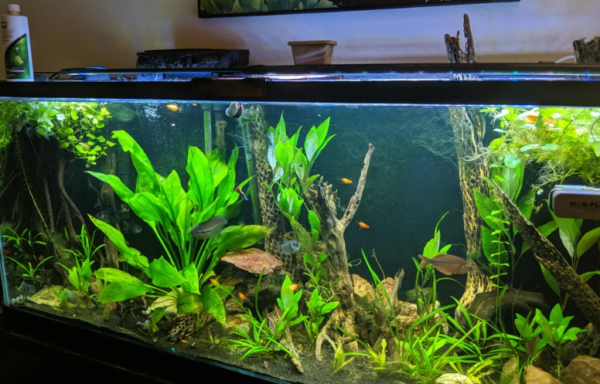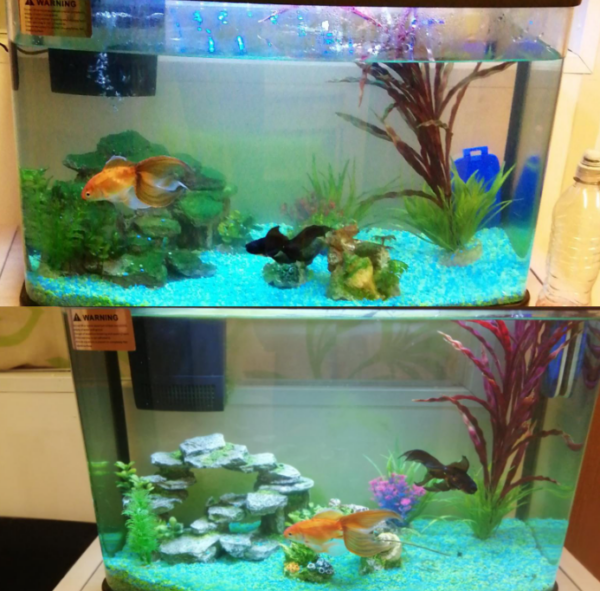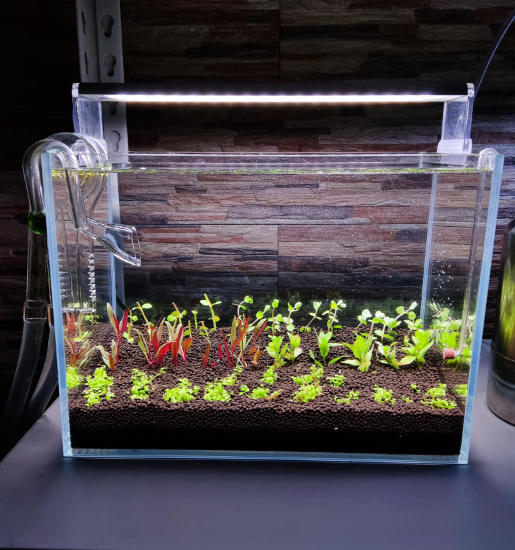[ad_1]
Most beginner aquarium enthusiasts are often unaware of the importance that water changes play in ensuring the well-being of your fish. I’ve personally seen numerous parent-child duos, with their tanks lacking regular maintenance, mistakenly believing that their fish are destined for short lifespans.
The truth is quite the opposite. Fish have the potential to thrive for years, even decades, with proper care and attention.
Organic debris, toxic compounds, and algae outbursts may prove to be detrimental to the fish living in your care. While mechanical and biological filters do a pretty good job of improving your tank’s clarity, regular water changes reduce the toxins and replenish essential minerals.
How to Change Tank Water?
In simple words, changing tank water requires draining a portion of water and replacing it with new clean water. Typically, weekly 10-25% water changes are advised for small to medium aquariums. In between, occasional substrate vacuuming, rinsing filter media, and cleaning of glass & decorations may also be involved.
Although the process is similar, freshwater and saltwater tank water changes vary in both frequency and preparation of water. Saltwater aquariums need more frequent water changes than freshwater tanks.
Steps to Change Tank Water
Diving into details, here are the steps you should maintain while changing tank water.
1. Determine the appropriate water change schedule
Maintaining an appropriate water change schedule is critical to keep a check on the toxic elements in the tank. Your appropriate water change schedule will depend on the following:
- Volume: The larger the aquarium, the less often you need to change the tank water. This is because larger aquariums dilute the toxins and waste products more than smaller ones.
- Fish species: If your aquarium consists of larger bioload fish species, such as goldfish, you must facilitate more frequent water changes. They tend to be messy and produce a lot of ammonia and nitrite through their wasteful eating habits and poop.
- Filter type: The filtration system of your aquarium would also determine the frequency and volume of water changes. For example, a fully stocked canister filter is more efficient in removing toxins than a HOB filter.
Moreover, efficient biological, mechanical, and chemical filters can delay the water change schedule by a few weeks in an emergency.

In terms of tank volume, your water change schedule should be as follows:
- For small aquariums (<10 gallons): 10-15% water change every week.
- For medium aquariums (10-50 gallons): 10-20% water change every two weeks.
- For larger aquariums: (>50 gallons): 10-25% water change every three weeks.
However, every tank is different. Start with a 10-15% water change weekly and monitor the nitrite levels. If it starts to get too high, increase the frequency of water changes.
2. Gather the necessary equipment to change the tank water
Don’t fumble trying to find a bucket after you’ve started siphoning the water and already have run your floor. Here are a few basic things to perform a successful water change.
- Bucket: Get a clean bucket, optimally, that isn’t used for anything else. It’ll be used to siphon the substrate and condition new water.
- Siphon: Choose a manual siphon, automatic siphon, or pump. Start by siphoning the water from the bottom to remove any debris sitting at the bottom.
- Water conditioner: Chlorine is harmful to your fish. While using tap water, dechlorinate with the conditioner in the bucket before adding the new water to the tank.
- Thermometer: Ensure that the temperature of the new water is similar to the tank water. If not, heat it up or cool it down.
- Hydrometer or salinity refractometer: Check the salinity of the new water for your saltwater aquarium.
- Water parameter testing kits: Keep your water parameter testing kits handy to measure pH, hardness, ammonia, nitrite, nitrate, and oxygen levels in your freshly water-changed tank.
3. Unplug electrical equipment
Any electrical component that isn’t involved in the process (the pump, for example) should be unplugged before. A few of them may include:
- Heaters: Prioritize unplugging the heater before draining. As these submerged heaters aren’t meant to be operated without water, they may overheat and size to operate. You may also damage their glass armor during cleaning.
- Filters: It’s better not to leave the filter running without water. Even if you don’t do a 100% water change, it’s advised to unplug and remove the filter head altogether before starting the water change.
- Lighting: Most lighting setups are removable from the aquarium body. Unplug the lights to prevent them from getting wet and being damaged.
- Air Pumps: You can keep the air pumps running while changing water, but as you’ll probably be cleaning the tank in the dark, you may accidentally disengage the joints.
Any other electrical equipment, like wavemakers and timers, should also be removed before you change the tank water.
4. Siphon the substrate
If you don’t have plants in your tank, you can siphon the whole floor to eliminate unwanted food and other organic debris. However, we actively avoid siphoning the whole substrate while water changes to avoid knocking the beneficial bacteria back. A ⅓ to ½ weekly cleaning is optimum for medium to larger tanks.
Always use a siphon designed for tanks that don’t drain too much water. Too much suction can disturb the substrate and cause stress to your fish, who already are under a lot of stress due to the water change routine.
For larger tanks, where you need to use larger suction tubes, use a two-part siphon. This type of product allows you to prevent the siphon from sucking up too much water. Moreover, keep an eye on the chemical levels after deep substrate siphon to readily manage the expected nitrite spike.
Depending on the substrate type, here are a few tips that may help you out:
- Gravel: Push the tube down below the gravel until you see a plume of fish poop and rotten food rise. Repeat the process throughout. Gravel with plants needs to be handled more carefully.
- Sand: Sand is lighter than gravel and can be sucked out with a stronger siphon. Use a longer hose to reduce the suction capacity. If you have burrowing fish, be extra careful.
- Soil: For planted tanks, siphon through a light mesh to prevent soil from ending up in the bucket and leaving a void behind. Plants may also be uprooted with strong suction.
5. Clean the decorations and glass

If you are being careful not to use it in excess, bleach and vinegar can be used to clean the decorations.
- Mix a solution of 1 part vinegar and 3 parts water. Soak the decorations up for 10 minutes before rinsing them with aquarium water.
- Use 1 part bleach and 10 parts water in a bucket to soak the decoration up. Rinse them before dropping them back into the tank.
- For the internal surface of the glass, just use a wet traditional or magnetic sponge. Although a very dilute solution of vinegar may work, it can lower the pH. Do the internal glass cleaning while the water is still in the tank and the lights are present.
Tip: Don’t let the bleach end up in your aquarium. Use dechlorinated water to rinse them thoroughly for at least 10-15 minutes. Use warm water if available.
6. Rinse filter media
Rinsing the filter media allows them to work more efficiently. As chlorinated tap water kills the beneficial bacteria, use dechlorinated water to clean the media.
Sponges, filter floss, and aqua mesh can be rinsed out by squeezing them in the bucket. However, it’s better to replace finer media after they’ve been clogged.
Lightly rinse bio balls and ceramic rings with aquarium water to remove any built-up algae on them. If they’ve been decayed (eaten out) by bacteria, consider replacing or adding more in the chamber to keep the colony thriving.
You don’t need to clean and rinse filter media every week. Give them a thorough rub once a month for optimum results. Don’t soak them in any cleaning agent, including bleaching and vinegar.
If you want to know ‘how to choose the right freshwater aquarium filter?’ click here.
7. Prepare new water (Freshwater and saltwater)
Unless you have specific requirements for water parameters, which in most cases are present, use regular dechlorinated tap water. If accessible, use RO water and prepare them before introducing it to the existing water.
For freshwater,
- Use RO water or dechlorinate the tap water.
- Adjust pH levels to match the existing water parameters and requirements.
- Adjust the new water temperature to avoid temperature spikes and stressing the fish. I personally like to keep the new water a few degrees cooler to simulate rainwater (10-15% water change). But, it isn’t advised for beginner enthusiasts.
- Reintroduce minerals and trace elements in the water. Check for GH and KH levels of the tank to ensure that the parameters are as expected.
For saltwater,
- Use either RO or tap water. As the salt mix is to be added, the origin of the water isn’t as critical as freshwater.
- Measure the amount of water you need and the amount of salt you may need (Calculable from the instructions on the salt mix).
- Mix the water and salt until the salt is completely dissolved. Check the salinity of the water with a hydrometer.
- Adjust the salinity if required and let it sit for 24 hours for the chlorine and chloramine to dissipate.
8. Carefully pour the new water

Place the decorations, filter media, and electrical equipment in the water and pour the prepared water into your tank slowly. Avoid spooking the fish or disturbing the gravel while doing so. Use a buffer of some kind, like a pitcher or a jug, to steadily pour the water in.
If you’re pouring water directly from a tap (not recommended, but can be used if you frequently change tank water), turn the water pressure down by using similar buffers or using a valve.
9. Check water parameters
After you’re done with the water change, let it sit for a few hours and check the parameters. This includes pH, ammonia, nitrite, nitrate, GH, KH, salinity, temperature, and oxygen level tests. If everything is in the acceptable range, wait for them to come to equilibrium.
However, if one or a few of the parameters seem skewed, take appropriate measures to correct them.
In most skewed cases, chlorine spikes, nitrite overload, pH imbalance, and hardness instability are observed. A few methods to correct them are:
- To increase pH, add crushed coral or use a pH increaser. Wait for a few hours after the water change before employing the methods.
- To decrease pH, use a ph reducer available commercially. They usually include mild acidic compounds to help lower the pH.
- To reduce chlorine levels (optimally zero) in your water, use a water conditioner or activated carbon in your filter. Typically, chlorine, if not intolerable, evaporates from the water over time.
- To increase hardness (GH and KH), add crushed corals and water conditioners.
- To decrease hardness, we use peat moss and commercial conditioners.
- Nitrite levels are maintained by the beneficial bacteria and frequent water changes.
10. Monitor the fish after the tank water change
Stay hostile for at least 24 hours after the water changes to observe any irregular behavior in your fish. Common water quality-related symptoms include:
- Gasping for air, erratic swimming, and clamped fins. (Low pH)
- Lethargy, white spots on the body, and loss of appetite. (High pH, nitrite, or nitrate)
- Red streaks on the body, gasping for air, and erratic swimming (High Ammonia)
- Clamped fins, white spots on the body, difficulty swimming (Low Hardness)
Test water parameters and take appropriate measures if these symptoms are noticeable.
Also check out our article on “Top 20 Best Freshwater Aquarium Plants For Beginners“.
FAQs
Depending on your tank volume and type, you should aim for 10-20% water change every 1-3 weeks. Larger aquariums need less frequent water changes, while smaller ones require more. Saltwater tanks should be maintained more frequently than freshwater aquariums.
There is no safe limit to how much water you should change in every cycle. High-maintenance aquariums, like with Oscars, need frequent and massive water changes of up to 90%. As long as you’re following the procedure, the volume shouldn’t negatively impact the health of your tank.
Dechlorinate the water, remineralize it, adjust the pH and temperature, and you’re good to go for a freshwater tank. For saltwater tanks, you need to use a commercially available salt mix to salinate the water.
The Bottom Line
Water changes are critical to sustaining a healthy tank environment. In addition to reducing harmful compounds, water changes replenish essential minerals, dilute excessive nutrients, and improve clarity. For the best results, follow this article, even bookmark it, to understand how to change tank water.
[ad_2]
Source link
